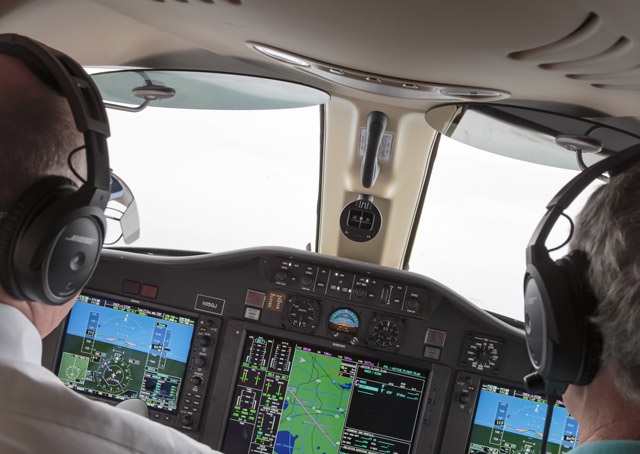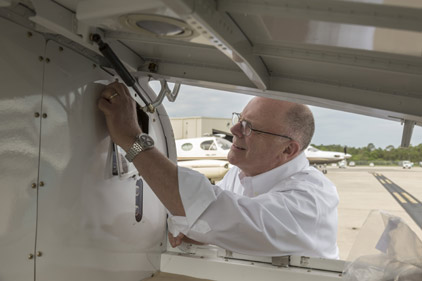
Congratulations—you’ve passed your checkride and earned a type rating endorsing you for single-pilot operations in a light jet. But your testing days in jets are far from over. To keep your jet-pilot privileges alive, you’ll have to pass an annual proficiency exam. The regulations spell out this requirement in FAR Part 61.58, titled “Pilot-in-command proficiency check: Operation of an aircraft that requires more than one pilot flight crewmember or is turbojet-powered.” (And yes, the term “turbofan” is implied in the regs’ use of the rather dated “turbojet” definition). At first glance the rule seems applicable only to pilots of two-crew jets. The catch is the “or” in the rule title, which targets the entire jet-pilot community.
Pilots flying for the airlines, fractional ownership operations, or charter outfits can comply with this rule through their own proficiency checks, or via an advanced qualification program approved under Subpart Y of FAR Part 121. In addition, an approved flight simulator operated under FAR Part 142 (training centers) can be used to satisfy the rule. So can certain operators offering approved FAR Part 61 training programs. And a proficiency check in an airplane requiring and manned by two pilot crewmembers, or an approved simulator replicating such an airplane, also can be used to comply with single-pilot annual proficiency rules. As for pilots of single-seat, Experimental-category turbojets/turbofans, compliance is not required.
There are more twists in the regulations if you’re typed in multiple airplanes. If you’re typed in three airplanes, for example, you must have had a 61.58 check in all of them within the past 24 months, making sure that you’ve completed one of those checkrides within the past 12 months—which works out to a checkride every eight months.
When I earned my type ratings—in Embraer’s Phenom 300 and Cessna’s Citation Mustang—I had this idea that the 61.58 ride would be a simple matter. Maybe just a trip around the pattern, an approach or two, and the obligatory three takeoffs and landings. How wrong I was! The 61.58 ride amounts to a repeat of the full, initial type rating checkride, complete with simulated emergencies and procedures that must be flown to the practical tests standards set down for airline transport pilots.
This past April, it was time for my second annual 61.58 ride. And once more, I went to Azma FLT Incoporated, which is based at the Orlando Executive Airport in Florida. That’s where I first earned my Cessna Citation Mustang type rating. John Azma, founder of Azma FLT and a designated pilot examiner, believes in a personalized approach to flight training—an approach that I explored in the August 2013 issue of AOPA Pilot’s Turbine Edition (see “One on One Type Training”). Azma employs 12 instructors who prepare some 200 to 250 pilots per year for their type ratings, with the primary emphasis on Cessna’s Mustang and Beechcraft’s Premier I and IA. Even so, type training—in the airplane—extends to the rest of the single-pilot Cessna jets, Learjets, and Dassault’s Falcon 50. Azma claims his is one of the largest turbine training centers in the world for aircraft-based training; no simulators here. And for 61.58 proficiency checks in the Mustang, he’s an especially good choice. He says he averages two 61.58 Mustang checkrides a week.
My recent checkride began several weeks before I showed up at Azma’s offices. I was sent extensive summaries of all the Mustang’s systems, and asked to memorize the, well, memory items. Once on site, the checkride was prefaced by four hours of ground school in a morning session. First came a thorough review of all of the Mustang’s airspeed and structural limitations, plus the memory items for various emergencies. These would be the first two to four actions that the pilot must perform immediately, in dire situations where there’s no time to consult an emergency checklist—such as fires, smoke in the cockpit, loss of both generators, or autopilot runaways.
In many cases, Azma’s advice goes beyond the checklist. Take a brake failure. You wouldn’t know your brakes were inoperative until you touched down, tried to apply them, and they didn’t work. The checklist says to use the emergency pneumatic brake lever to stop. But unless your touchdown was on speed and on the numbers, and you pulled on the brake lever immediately, chances are you’d run off the runway. Azma’s advice: Go around, and make your next touchdown at the runway threshold. Flying to an airport with a nice long runway would be another wise choice.
The checkride itself wasn’t as tense or nerve-wracking as I was expecting. Azma has a way of putting one at ease, even as he goes through the paces. There was a V1 cut on my first takeoff, followed by an RNAV GPS approach to the Leesburg, Florida, airport ending in a circle-to-land maneuver, followed by a missed approach and hold, then a single-engine ILS to Runway 27 at the Sanford Regional Airport, and finally a no-flaps ILS approach to Orlando International’s Runway 36L. In between those procedures were a stall series, steep turns, and other required maneuvers. The flight lasted just more than 1.5 hours and when it was done I had not only my 61.58 completed, but a flight review and instrument proficiency check as well.
What if I hadn’t done well on the 61.58 checkride? Like the flight review, it’s a pass-fail test, and a poor showing would mean no endorsement entry in my logbook. I’d have to fly another checkride and fly the procedure(s) I botched to earn approval. Depending on the local Flight Standards District Office rules, an examiner may offer another in-flight chance to repeat the failed maneuver. The 61.58 checkride is another angst-provoking hoop that pilots must jump through, but once you’ve knocked off some rust, passed, and learned something new—like I did—you’ll see this is one of the FAA’s best-intentioned rules.
Email [email protected]
Photography by Mike Fizer
The 61.58 requirement in its current form didn’t exist until November 2012. Before then, only pilots of two-crew jets were subject to annual proficiency checks. The rise of the very light jet, as well as the increasing popularity of single-pilot light jets in general, was the prime mover in prompting the FAA to enact the “new” 61.58 requirement. The thought of all those owner-flown jets, essentially flying under proficiency and recurrency rules intended for piston-powered airplanes, must have seemed too lenient for those flying jets deep in the flight levels, and flying approach and departure profiles at much higher speeds.

The 61.58 checkride is not a few laps around the pattern and a quick signoff. You must perform what amounts to the entire type rating checkride, right down to the preflight checks of the baggage compartment’s oxygen and emergency brake system pressure gauges.



